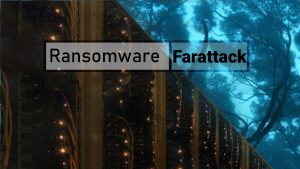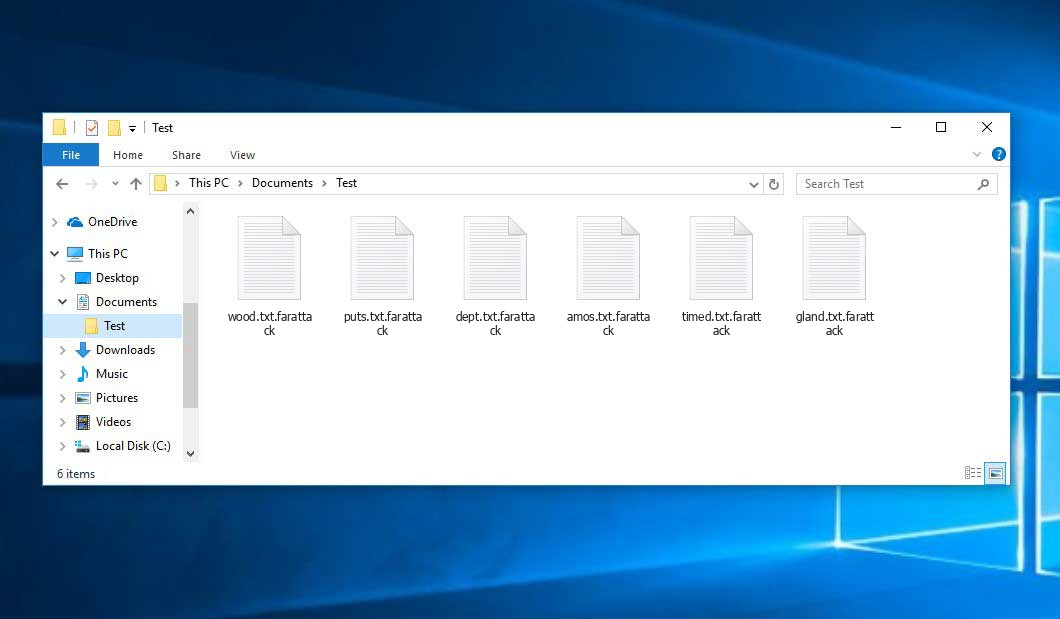The Farattack virus falls within the ransomware type of malicious agent. Malware of this type encrypts all user’s data on the computer (photos, text files, excel tables, music, videos, etc) and appends its own extension to every file.
What is Farattack?
☝️ A scientifically accurate description for the Farattack is “a ransomware-type malicious agent”.
Farattack appends its extra .farattack extension to every file’s title. For instance, an image named “photo.jpg” will be altered to “photo.jpg.farattack”. In the same manner, the Excel sheet with the name “table.xlsx” will be renamed to “table.xlsx.farattack”, and so on.
The ransom note usually contains instructions on how to buy the decryption tool from the racketeers. That is how they do it.
Farattack abstract:
| Name | Farattack Virus |
| Extension | .farattack |
| Detection | Win32/Packed.CAB.Y suspicious, Ransom:Win32/Seven.MAK!MTB, Win32:Agent-AULS [Trj] |
| Symptoms | Your files (photos, videos, documents) get a .farattack extension and you can’t open them. |
| Fix Tool | See If Your System Has Been Affected by Farattack virus |
In the screenshot below, you can see what a folder with files encrypted by the Farattack looks like. Each filename has the “.farattack” extension added to it.
How did my computer get infected with Farattack ransomware?
There is a huge number of possible ways of ransomware infiltration.
Nowadays, there are three most exploited ways for tamperers to have the Farattack virus working in your digital environment. These are email spam, Trojan infiltration and peer-to-peer networks.
If you open your mailbox and see emails that look like familiar notifications from utility services providers, postal agencies like FedEx, web-access providers, and whatnot, but whose mailer is unknown to you, be wary of opening those emails. They are most likely to have a ransomware file attached to them. Therefore, it is even more dangerous to open any attachments that come with emails like these.
Another option for ransom hunters is a Trojan file model1. A Trojan is a program that gets into your machine pretending to be something else. For example, you download an installer for some program you need or an update for some software. However, what is unboxed turns out to be a harmful agent that compromises your data. As the update wizard can have any name and any icon, you have to make sure that you can trust the resource of the things you’re downloading. The optimal thing is to use the software developers’ official websites.
As for the peer networks like torrents or eMule, the danger is that they are even more trust-based than the rest of the Web. You can never guess what you download until you get it. Our suggestion is that you use trustworthy resources. Also, it is reasonable to scan the folder containing the downloaded files with the anti-malware utility as soon as the downloading is done.
How to remove the Farattack virus?
It is important to inform you that besides encrypting your data, the Farattack virus will probably install the Azorult Spyware on your machine to get access to credentials to various accounts (including cryptocurrency wallets). The mentioned program can extract your credentials from your browser’s auto-filling cardfile.
Sometimes racketeers would decode few of your files so you know that they indeed have the decryption program. As Farattack virus is a relatively new ransomware, anti-malware developers have not yet found a way to reverse its work. However, the decoding instruments are frequently upgraded, so the effective countermeasure may soon arrive.
Of course, if the evildoers succeed in encoding someone’s critical data, the desperate person will probably fulfill their demands. However, paying to racketeers gives no guarantee that you’re getting your blocked information back. It is still dangerous. After receiving the money, the racketeers may send a wrong decryption key to the victim. There were reports of criminals simply vanishing after getting the money without even writing back.
The best countermeasure to ransomware is to have aan OS restore point or the copies of your essential files in the cloud storage or at least on an external disk. Of course, that might be not enough. Your most important thing could be that one you were working upon when it all happened. But at least it is something. It is also advisable to scan your drives with the antivirus program after the OS is rolled back.
Farattack is not the only ransomware of its kind, since there are other specimens of ransomware out there that act in the same manner. Examples of those are Vfgj, Maak, Zaqi, and some others. The two main differences between them and the Farattack are the ransom amount and the encoding method. The rest is almost identical: documents become blocked, their extensions altered, ransom notes are found in each directory containing encoded files.
Some lucky people were able to decode the blocked files with the help of the free tools provided by anti-malware developers. Sometimes the racketeers accidentally send the decryption code to the victims in the ransom note. Such an epic fail allows the injured part to restore the files. But of course, one should never expect such a chance. Remember, ransomware is a bandits’ instrument to pull the money out of their victims.
How сan I avoid ransomware attack?
Farattack ransomware doesn’t have a endless power, so as any similar malware.
You can protect your system from ransomware attack within three easy steps:
- Ignore any letters from unknown mailboxes with strange addresses, or with content that has likely no connection to something you are waiting for (can you win in a lottery without even taking part in it?). In case the email subject is likely something you are waiting for, check all elements of the suspicious letter with caution. A fake letter will surely contain a mistake.
- Never use cracked or unknown programs. Trojans are often spreaded as a part of cracked products, most likely under the guise of “patch” to prevent the license check. But potentially dangerous programs are difficult to tell from reliable software, because trojans sometimes have the functionality you seek. Try searching for information about this software product on the anti-malware message boards, but the optimal solution is not to use such software.
- And finally, to be sure about the safety of the files you downloaded, check them with GridinSoft Anti-Malware. This software will be a perfect defense for your PC.
Reasons why I would recommend GridinSoft2
There is no better way to recognize, remove and prevent ransomware than to use an anti-malware software from GridinSoft3.
Download Removal Tool.
You can download GridinSoft Anti-Malware by clicking the button below:
Run the setup file.
When setup file has finished downloading, double-click on the setup-antimalware-fix.exe file to install GridinSoft Anti-Malware on your PC.

An User Account Control asking you about to allow GridinSoft Anti-Malware to make changes to your device. So, you should click “Yes” to continue with the installation.

Press “Install” button.

Once installed, Anti-Malware will automatically run.

Wait for the Anti-Malware scan to complete.
GridinSoft Anti-Malware will automatically start scanning your computer for Farattack infections and other malicious programs. This process can take a 20-30 minutes, so I suggest you periodically check on the status of the scan process.

Click on “Clean Now”.
When the scan has completed, you will see the list of infections that GridinSoft Anti-Malware has detected. To remove them click on the “Clean Now” button in right corner.

FAQ
🤔 How can I open “.farattack” files?Is it possible to open“.farattack” files?
Unfortunately, no. You need to decipher the “.farattack” files first. Then you will be able to open them.
🤔 The encrypted files are very important to me. How can I decrypt them quickly?
Hopefully, you have made a copy of those important files. If not, there is still a function of System Restore but it needs a Restore Point to be previously saved. There are other ways to beat ransomware, but they take time.
🤔 Will GridinSoft Anti-Malware remove all the encrypted files alongside the Farattack virus?
Of course not. Unlike the ransomware program itself, the encrypted files do not jeopardize your system.
GridinSoft Anti-Malware only deals with actual viruses. The ransomware that has infiltrated your computer is must be still functional and running scans from time to time to arrest any new files you might create on your computer after the infection. As it has been said above, the Farattack malware does not come alone. It installs backdoors and keyloggers that can take your account passwords by trespass and provide malefactors with easy access to your PC after some time.
🤔 What to do if the Farattack virus has blocked my computer and I can’t get the activation key.
In such a case, you need to prepare a flash memory drive with a previously installed Trojan Killer. Use Safe Mode to execute the procedure. The point is that the ransomware starts automatically as the system launches and encodes any new files created or brought into your machine. To stop this process – use Safe Mode, which allows only the vital applications to run upon system boot. Consider reading our manual on running Windows in Safe Mode.
🤔 And what should I do now?
Many of the encrypted files might still be at your disposal
- If you sent or received your critical files via email, you could still download them from your online mail server.
- You may have shared images or videos with your friends or relatives. Simply ask them to post those pictures back to you.
- If you have initially downloaded any of your files from the Internet, you can try doing it again.
- Your messengers, social networks pages, and cloud disks might have all those files as well.
- It might be that you still have the needed files on your old computer, a laptop, cellphone, external storage, etc.
HINT: You can use data recovery utilities4 to get your lost data back since ransomware encodes the copies of your files, removing the authentic ones. In the tutorial below, you can learn how to recover your files with PhotoRec, but be advised: you won’t be able to do it before you eradicate the ransomware itself with an antivirus program.
Also, you can contact the following official fraud and scam sites to report this attack:
- In the United States: On Guard Online;
- In Canada: Canadian Anti-Fraud Centre;
- In the United Kingdom: Action Fraud;
- In Australia: SCAMwatch;
- In New Zealand: Consumer Affairs Scams;
- In France: Agence nationale de la sécurité des systèmes d’information;
- In Germany: Bundesamt für Sicherheit in der Informationstechnik;
- In Ireland: An Garda Síochána;
To report the attack, you can contact local executive boards. For instance, if you live in USA, you can have a talk with FBI Local field office, IC3 or Secret Service.
I need your help to share this article.
It is your turn to help other people. I have written this guide to help people like you. You can use the buttons below to share this on your favorite social media Facebook, Twitter, or Reddit.
Brendan SmithHow to Remove FARATTACK Ransomware & Recover PC

Name: FARATTACK Virus
Description: FARATTACK Virus is a ransomware-type infections. This virus encrypts important personal files (video, photos, documents). The encrypted files can be tracked by a specific .farattack extension. So, you can't use them at all.
Operating System: Windows
Application Category: Virus
User Review
( votes)References
- You can read more on Trojans, their use and types in the Trojan-dedicated section of GridinSoft official website.
- GridinSoft Anti-Malware Review from HowToFix site: https://howtofix.guide/gridinsoft-anti-malware/
- More information about GridinSoft products: https://gridinsoft.com/comparison
- Here’s the list of Best Data Recovery Software Of 2023.


